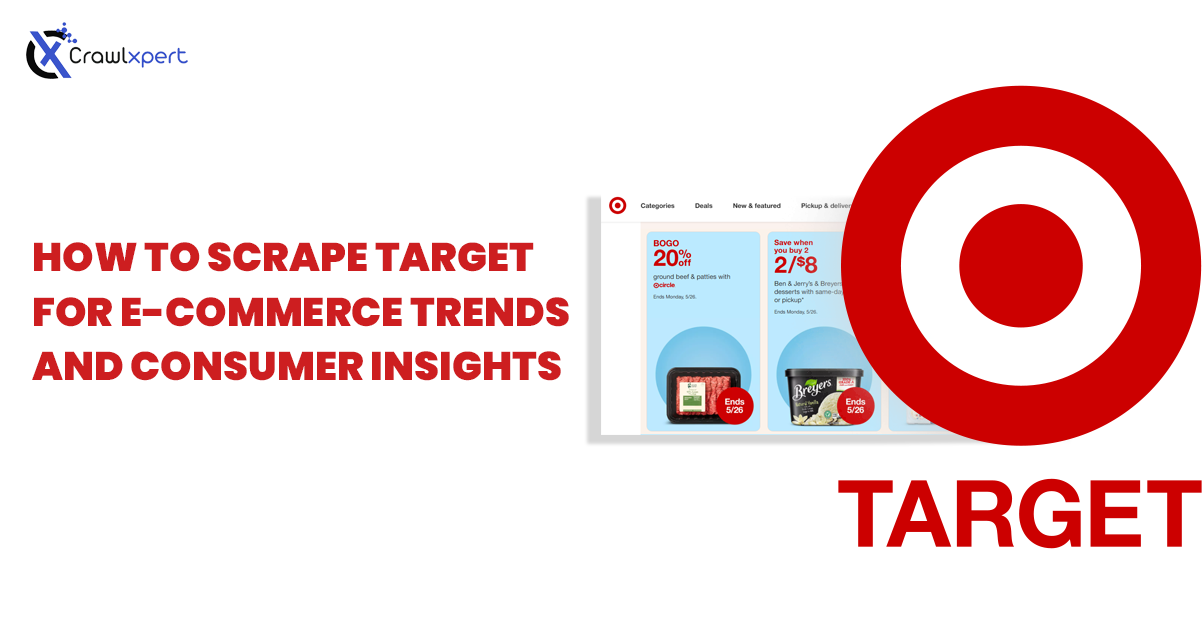
How to Scrape Target for E-Commerce Trends and Consumer Insights
Published on October 13, 2025
Introduction
It is all about monitoring the behavior of consumers as they could change with time by keeping up with the trends, then it moves on from there. America is endowed with big retail giants, and one of its large retail conglomerates is the Target Corporation, which always has a pool of information concerning the trends in e-commerce.
It holds information from product listings and pricing strategies to customer reviews and promotions. It has all the possible information that one would get about an online retailer.
In this blog, we will step by step help one scrape Target smartly to get workable data for competitive intelligence and better business strategies. Regardless of whether you are an e-commerce entrepreneur, a market analyst, or simply a data geek, you will better understand what data from Target would mean to unlock some key consumer insights to keep you ahead of the game when it comes to the e-commerce market.
We are covering tools, methodologies, ethical considerations, and practical use cases—everything that you need for an advanced-level understanding of scraping Target for e-commerce trends and consumer insights.
Why Scrape Target?
Before we discuss the "how," let us consider the "why" for a bit. Target's vast catalog contains thousands of products in various categories like electronics, home goods, groceries, apparel, and more. By scraping this data, you can find insights like:
- Product Popularity Trends: Identify which products are frequently updated, well-reviewed, or highly rated.
- Pricing Strategies: Understand dynamic pricing, discount patterns, and seasonal offers.
- Inventory Changes: Track out-of-stock or in-stock status to assess demand.
- Customer Sentiment: Analyze reviews and ratings to determine consumer preferences and pain points.
- Promotional Tactics: Observe how Target markets its deals and flash sales.
Accessing and analyzing this data provides valuable foresight into market demand, inventory trends, and consumer behavior.
Understanding Target’s Website Structure
- Product Listings: Category pages contain products with images, prices, ratings, and promotional badges.
- Product Detail Pages (PDP): Each product page contains descriptions, specifications, availability, and user reviews.
- Dynamic Content Loading: Some parts of the page load asynchronously via JavaScript.
- URL Patterns: Target uses predictable URL structures for categories and products.
Tools and Technologies for Scraping Target
- Python + BeautifulSoup: Great for static HTML parsing.
- Python + Selenium: Handles dynamic JavaScript rendering.
- Scrapy: Scalable web crawling framework.
- Puppeteer: Node.js library for headless browsers.
- API Monitoring Tools: Identify internal APIs used by Target.
- Proxies & Rotating IPs: Prevent IP bans and rate limits.
Step-by-Step Guide to Scraping Target
- Define Objectives: product titles, prices, stock, categories, ratings, reviews, promotions.
- Analyze Web Pages: inspect elements & monitor network calls.
- Build Your Scraper: e.g. Python + Selenium.
- Handle Dynamic Content: wait for elements before scraping.
- Implement Anti-Detection: proxies, UA rotation, delays, simulate clicks.
- Store & Analyze: save to CSV/DB → analyze with Pandas, Tableau, Power BI.
Extracting E-Commerce Trends from Target Data
- Price Fluctuation Analysis: seasonal discounting, flash sales.
- Inventory Movement: track high-demand products, launches, cycles.
- Consumer Sentiment Analysis: NLP on reviews for sentiment polarity.
- Product Popularity Index: based on reviews, ratings, promotions.
- Trend Mapping: emerging categories, regional patterns.
Ethical Considerations and Legal Compliance
- Respect robots.txt
- Avoid scraping personal information
- Use data ethically
- Follow Target’s TOS & seek legal advice if needed
Use Cases of Target Data Scraping
- Competitor Price Monitoring
- Market Research & Product Development
- Dynamic Pricing Strategy
- Inventory Planning
- Consumer Sentiment Analysis
Overcoming Scraping Challenges
- Rate Limiting: IP rotation, delays.
- CAPTCHA: Solvers/manual handling.
- Dynamic Content: Headless browsers, API interception.
- Data Volatility: Scrape at regular intervals.
Future-Proofing Your Target Scraping Strategy
- Monitor Site Changes
- Data Enrichment with external sources
- Automation & alert pipelines
Conclusion
Scraping Target for e-commerce trends and consumer insights is a strategic way to stay competitive. By using appropriate tools, following ethical practices, and having a clear direction, you can extract precious data on pricing, inventory, market research, and more.
Whether you are an entrepreneur, strategist, or data geek, Target scraping provides an edge — but remember, true value lies not in collection, but in meaningful interpretation.

